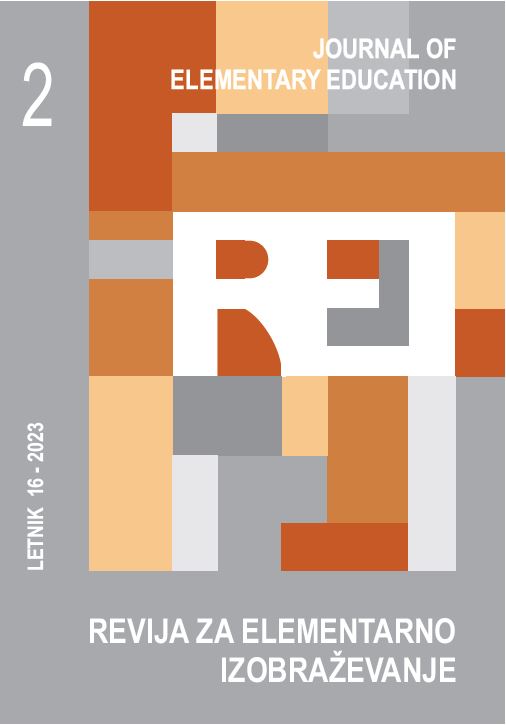Cognitive Efficiency of Slovenian, Indian and Gambian Gifted Students in Performing Mental Tasks
Abstract
In this paper, we present a comparative analysis between registered gifted Slovenian, Gambian, and Indian students in which we sought to find out how they perform in solving selected mental tasks, where we were focused on logical-mathematical and spatial intelligence as a function of the social environment from which the students came. We found that the results for the test groups differed. Out of ten task sets, Slovenian students performed better than their Indian and Gambian peers in as many as seven task sets; in four tasks we found a statistically significant difference between Slovenian and Indian children, and a comparison between Slovenian and Gambian students shows that Slovenian children scored better on mental task sets in all groups.
Downloads
References
Binet A. in Simon, T. (1916). The Development of Intelligence in Children. Baltimore; Williams & Wilkins; New York: Arno Press.
Bucik, N., Bucik, G. in Bucik, V. (2013). Misleca: Miselne naloge za mlade bistroume. Ljubljana: Mladinska knjiga.
Bucik, V. (1997). Osnove psihološkega testiranja. Ljubljana: Filozofska fakulteta, Oddelek za psihologijo.
Cattell, R. B. in Horn, J. L. (1978). A check on the theory of fluid and crystallized intelligence with description of new subtest designs. Journal of Educational Measurement, 15, 139–164.
Cherry, K. (2018). Theories of Intelligence. Pridobljeno s https://www.verywellmind.com/theories-of-intelligence. (Dostopno: 28. 1. 2022)
Conklin, S. M., Gianaros, P. J., Brown, S. M., Yao, J. K., Hariri, A. R., Manuck, S. B, et al. (2007). Long-chain omega-3 fatty acid intake is associated positively with corticolimbic gray matter volume in healthy adults. Neuroscientific Letter, 421, 12.
Der, G., Batty, G. D., in Deary, I. J. (2006). Effect of breast feeding on intelligence in children: Prospective study, sibling pairs analysis and meta-analysis. BMJ, 333–945.
DiLalla L. F. (2000). Development of intelligence: Current research and theories. Journal of School Psychology, 38, 3–7.
Galton, F. (2012). The history of twins, as a criterion of the relative powers of nature and nurture. International Journal of Epidemiology, 41(4), 905–11. doi: 10.1093/ije/dys097.
Gardner, H. (1995). Razsežnosti uma: Teorija o več inteligencah. Ljubljana: Tangram.
Jurman, B. (2004). Inteligentnost, ustvarjalnost, nadarjenost. Ljubljana: Center za psihodiagnostična sredstva.
Kompare, A., Stražišar, M., Vec, T., Dogša, I., Jaušovec, N. in Curk, J. (2001). Psihologija: Spoznanja in dileme. Ljubljana: DZS.
Koncept prepoznavanja nadarjenih otrok, učencev in dijakov ter vzgojno-izobraževalnega dela z njimi (2019). Pridobljeno s https://www.zrss.si/zrss/wp-content/uploads/2020-03-11-koncept-nad.pdf (Dostopno: 28. 1. 2022)
Marentič Požarnik, B. (2000). Psihologija učenja in pouka. Ljubljana: DZS.
Marjanovič Umek, L. in Zupančič, M., (2004). Razvojna psihologija. Ljubljana: Znanstveni inštitut Filozofske fakultete.
Makharia, A., Nagarajan, A., Mishra, A., Peddisetty, S., Chahal, D., in Singh, Y. (2016). Effect of environmental factors on intelligence quotient of children. Industrial Psychiatry Journal, 25, 189–194.
More, S., Shivkumar, V. B., Gangane, N., in Shende, S. (2013). Effects of Iron Deficiency on Cognitive Function in School Going Adolescent Females in Rural Area of Central India. Anemia. doi: 10.1155/2013/819136
Musek, J. in Pečjak, V. (1997). Psihologija. Ljubljana: Educy.
Nisbett, R. E, Aronson, J., Blair, C., Dickens, W., Flynn, J., in Halpern, D.F. (2012). Intelligence: New findings and theoretical developments. American Psychology, 67, 130–159.
Pogačnik, V. (1995). Pojmovanje inteligentnosti. Radovljica: Didakta.
Repovš, G. (2007). Možgani in osebnost. Pridobljeno s http://www.sinapsa.org/tm/media/priponke/a-188-Mozgani%20in%20osebnost.pdf. (Dostopno: 30. 1. 2022)
Sattler, J. M. (2008). Assessment of Children: Cognitive foundations (5th ed.). San Diego, CA.
Spearman, C. (1927). General Intelligence, Objectively Determined and Measured. The abilities of man. London: Macmillan.
Sternberg, R. J. (2018). Human Intelligence. Pridobljeno s https://www.britannica.com/science/hu-man-intelligence-psychology. (Dostopno: 22. 1. 2022)
Wechsler, D. (2003). Wechsler Intelligence Scale for Children-Fourth Edition. San Antonio: The Psychological Corporation.
Copyright (c) 2023 Mojca Kukanja Gabrijelčič, Ema Šavs, Teja Nemec

This work is licensed under a Creative Commons Attribution 4.0 International License.
